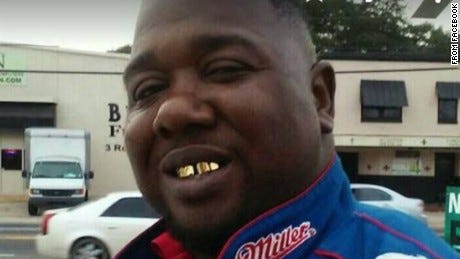The NY Daily News and the Imagery of the Black Body
How the media displays the bodies of dead black men is a chronic problem.
Early in the morning on Tuesday, July 5, Alton Sterling encountered two police officers outside of a convenience store in Baton Rouge. The Baton Rouge Police Department said after the fact that they were there to deal with a reported disturbance. According to this version of events, the storeowner had called the police to assist in subduing Sterling, who was harassing customers outside the store.
Whatever the case, when the police arrived they immediately attacked Sterling. They brought him down to the ground and restrained him. After Sterling was laid on his back with both of his arms restrained, the two officers emptied their pistols into him, shooting him six times.
This police killing would not have been captured on film without the efforts of two civilians with cell phones who released their recordings within 36 hours of the shooting, exposing the cold blooded murder. The recordings were major news moments. They were shared and viewed by millions across the country and around the world.
But the line between exposing state misbehavior and voyeurism is a thin one. The New York Daily News crossed that line with its cover for its Thursday edition, showing a screenshot of Sterling’s bloody body from one of the videos. The moment in question showed him lying on his back immediately after being shot. It was literally a picture of a dying man breathing his last.
The Daily News used the image throughout its social media reporting on Wednesday, July 6:
1:47 AM, the News tweets out an image of Sterling restrained, right as the officer pulls out his weapon
11:15 AM, the News posts a different shot from the same video
2:07 PM, the News posts the image that will be on the cover of the next day’s paper with the added bonus of talking about Sterling buying a gun
By the evening, the News had publicly broadcasted that the image of Sterling slowly dying would be the cover for the Thursday paper.
By a little after 9 PM Central Time a new image of black death had taken over the news cycle.
Police in Falcon Ridge, Minnesota, pulled over Philando Castile and shot him four times in the chest as he sat in the driver’s seat of the car he was driving.
Castile’s girlfriend, Diamond Reynolds, and her 4 year old daughter were in the car as well. Immediately after Castile’s shooting, Reynolds began broadcasting on Facebook Live, a livestreaming app. The audience, which would become global, watched as Castile slowly died in the driver’s seat.
Guess who posted images of his death from that video on Twitter?
1:06 AM, the News updates its audience that Castile has died with an image of his bleeding body from the video
So what does the constant visual assault of this morbid imagery mean for the American people?
A number of commentators over the past week have engaged with the imagery of dead black bodies and its roots in the US.
Zeba Blay from The Huffington Post:
It has become morbid entertainment, no different than a “barbecue,” a picnic, or a freak show oddity. From the lynchings of the Jim Crow era to the police killings of today, it’s not just the senseless killing ― it’s the record of it, the images recycled over and over again of hanging and bleeding and shot to death black bodies that seem to blur, that become one person, or rather, no person at all.
Angela Bronner Helm, NewsOne:
The New York Daily News was dead wrong in placing the gruesome image of Alton Sterling on its cover Thursday. The still of his dead body splayed on the concrete, blood covering his chest, eyes rolled in the back of his head while a Baton Rouge, Louisiana, police officer rolled on the ground next to him with his gun drawn like a scene from T.J. Hooker, was both disgusting and unconscionable…..
The only thing that that front page did was traumatize Black mothers, make White supremacists rejoice, and sell more papers. In my mind, publishing this photo is reinforcing the fact that Black lives don’t matter. The road to hell is paved with good intentions, and the hell of this Black death porn is just one more heartbreak on top of many.
Sherri Williams, NBC:
In the 24-hour news cycle videos of black death play every hour throughout the hour. National newspapers showcase photos of dead black bodies on front pages. Covering this violence is important and it’s necessary….
As a black scholar I want the injustices against black people to be recorded and shared in the interest of justice and history. But as a black woman I’m also worried about the mental and emotional health of my people as we continue to consume these videos.
I’m worried about how these images affect the mental and emotional health of us too.





